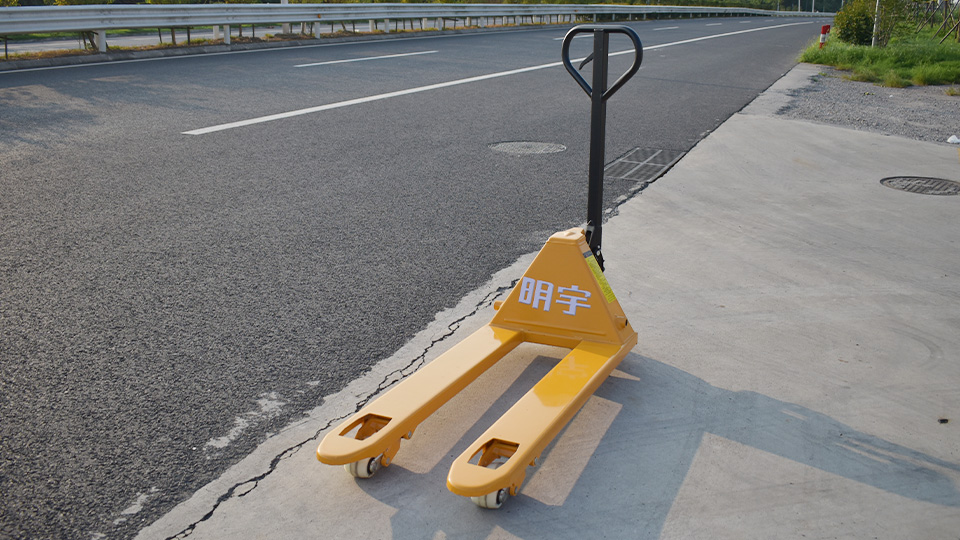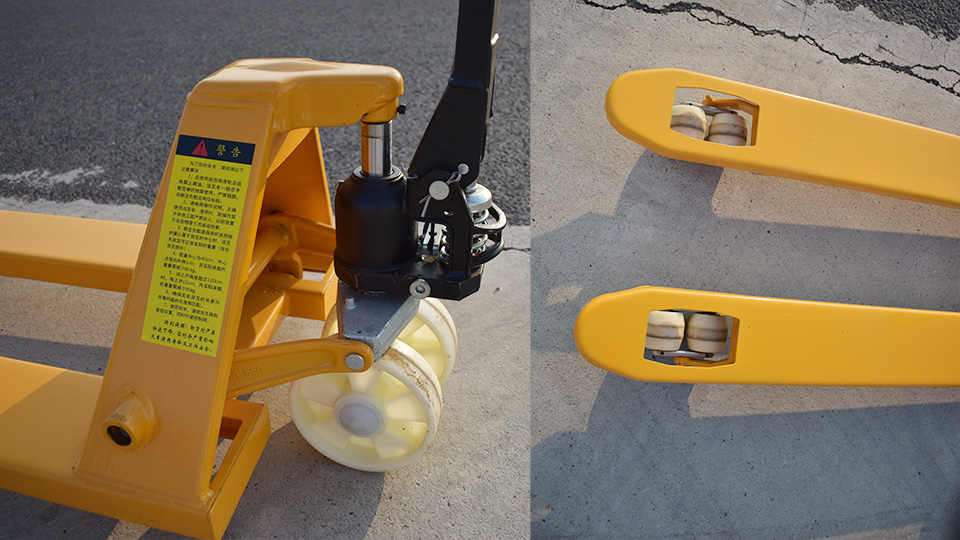
The hand pallet truck, often called a pallet jack or pump truck, stands as a cornerstone of material handling in warehouses, loading docks, and various industrial and commercial settings. Its simplicity belies its crucial role in efficiently moving palletized goods over short distances. While seemingly straightforward, the safe and effective operation of a hand pallet truck requires understanding its components, mastering fundamental techniques, and adhering to crucial safety protocols. This comprehensive guide delves into the intricacies of using a hand pallet truck, transforming novices into proficient operators and offering valuable insights for even experienced users.
I. Understanding the Anatomy of a Hand Pallet Truck:
Before attempting to operate a hand pallet truck, familiarity with its key components is paramount. Each part plays a vital role in its functionality and safe operation:
Forks: These are the two parallel steel arms that slide beneath the pallet to lift and support the load. Their length and width are designed to accommodate standard pallet dimensions.
Handle: This vertical lever serves multiple purposes: steering the truck, pumping hydraulic fluid to raise the forks, and releasing the pressure to lower the load. It typically features a comfortable grip and control levers.
Control Levers: Located on or near the handle, these levers govern the hydraulic system. Typically, there are three positions:
Raise (Pump): Pumping the handle up and down activates the hydraulic pump, lifting the forks.
Neutral: In this position, the handle can be moved freely for steering without affecting the fork height.
Lower: Engaging this lever releases the hydraulic pressure, allowing the forks to descend.

Wheels: Hand pallet trucks have two main types of wheels:
Steering Wheels: Located beneath the handle, these larger wheels allow the operator to maneuver the truck. They are typically made of polyurethane or nylon for durability and smooth rolling.
Load Wheels (Rollers): Situated at the tips of the forks, these smaller wheels support the weight of the load and facilitate movement across the floor. They are also made of durable materials to withstand heavy loads and friction.
Hydraulic Pump: This is the heart of the lifting mechanism. Manual pumping of the handle draws hydraulic fluid into a cylinder, extending the piston and raising the forks.
Frame: The robust steel frame provides structural integrity and supports the weight of the load and the operator's actions.
II. Pre-Operation Checks: Ensuring Safety and Functionality:
Before each use, a thorough inspection of the hand pallet truck is crucial to identify any potential hazards or malfunctions. This proactive approach significantly reduces the risk of accidents and equipment damage. The pre-operation checklist should include:
Visual Inspection: Examine the entire truck for any signs of damage, such as cracks, dents, or missing parts. Pay close attention to the forks, handle, and frame.
Wheel Condition: Check the steering and load wheels for wear, cracks, or debris that could impede movement. Ensure they rotate freely.
Hydraulic System: Inspect for any leaks around the hydraulic cylinder, hoses, and connections. Test the pump and control levers to ensure they operate smoothly and respond correctly. The forks should raise and lower without any jerky movements or excessive effort.
Handle and Controls: Verify that the handle is securely attached and that the control levers are easily accessible and function as intended. Ensure the handle locks securely in the upright position.
Load Capacity: Confirm that the hand pallet truck's rated load capacity is sufficient for the weight of the load to be moved. Overloading can lead to equipment failure and serious accidents. The load capacity is typically indicated on a label on the truck's frame.
Any identified defects should be reported immediately, and the hand pallet truck should be taken out of service until repairs are completed by qualified personnel.
III. The Art of Pallet Engagement: A Step-by-Step Guide:
Successfully engaging a pallet requires precision and awareness of the surroundings. Follow these steps carefully:
Approach the Pallet: Position the hand pallet truck squarely in front of the pallet. Ensure there is sufficient clearance around the pallet to maneuver the truck safely.
Align the Forks: Carefully align the forks with the openings in the pallet base. These openings are typically located on the longer sides of the pallet.
Lower the Forks: If the forks are raised, use the "Lower" control lever to bring them down to their lowest position.
Insert the Forks: Slowly push the hand pallet truck forward, guiding the forks fully into the pallet openings until the load wheels are positioned beneath the pallet. Ensure the forks are evenly inserted to provide balanced support.
IV. Lifting and Transporting the Load: Maintaining Control and Stability:
Once the forks are correctly positioned, the process of lifting and transporting the load requires careful execution:
Engage the "Raise" Function: Begin pumping the handle up and down in a smooth, consistent motion. This activates the hydraulic pump, gradually lifting the forks and the palletized load. Lift the load just high enough to clear the floor and any potential obstructions. Avoid lifting the load excessively high, as this can compromise stability.
Maintain Balance: Ensure the load is evenly distributed on the pallet. Unevenly distributed loads can make the truck unstable and increase the risk of tipping.
Steering Techniques: Use the handle to steer the hand pallet truck. Gentle, deliberate movements are key to maintaining control. Avoid sudden or jerky turns, especially when carrying heavy loads.
Pushing vs. Pulling: Generally, it is safer and more ergonomic to pull the hand pallet truck, allowing the operator to see the direction of travel and any potential hazards. However, in confined spaces, pushing might be necessary. When pushing, maintain a firm grip on the handle and move slowly.

Negotiating Obstacles: Approach ramps, uneven surfaces, and doorways slowly and cautiously. Avoid sharp angles when traversing obstacles. If an obstacle is too high or uneven, do not attempt to force the truck over it.
Awareness of Surroundings: Constantly scan the environment for pedestrians, other equipment, and potential hazards. Maintain a safe following distance from other moving equipment and adhere to any designated traffic lanes or safety guidelines.
Speed Control: Maintain a safe and manageable speed. Avoid running or moving too quickly, especially with heavy loads.
V. Lowering and Disengaging the Pallet: A Controlled Descent:
Lowering the load and disengaging the pallet requires a controlled and deliberate approach:
Position the Load: Carefully maneuver the hand pallet truck to the desired unloading location. Ensure the area is clear of obstructions and that the pallet can be safely lowered.
Engage the "Lower" Function: Slowly and steadily engage the "Lower" control lever. This releases the hydraulic pressure, allowing the forks and the load to descend gently to the floor. Avoid releasing the lever abruptly, as this can cause the load to drop suddenly and potentially damage the goods or the floor.
Disengage the Forks: Once the pallet is fully resting on the floor, pull the hand pallet truck backward, carefully withdrawing the forks from the pallet openings. Ensure the forks clear the pallet completely.
Lower the Forks Fully: After disengaging the pallet, lower the forks to their lowest position to prevent tripping hazards and ensure the truck is in a safe storage configuration.
VI. Safety First: Essential Practices for Preventing Accidents:
Operating a hand pallet truck safely is paramount to prevent injuries and damage. Adhere to the following crucial safety practices:
Wear Appropriate Personal Protective Equipment (PPE): This may include safety shoes, gloves, and eye protection, depending on the work environment and the nature of the load.
Never Exceed the Load Capacity: Overloading the hand pallet truck can lead to equipment failure, loss of control, and serious accidents. Always check the rated load capacity before lifting a load.
Ensure Stable Loads: Only move securely stacked and stable loads. Loose or improperly stacked items can shift during transport, causing instability and potential falls.
Keep Hands and Feet Clear: Always keep hands and feet away from the wheels and moving parts of the hand pallet truck during operation.
Maintain a Clear Line of Sight: Ensure you have a clear view of your path of travel and any potential hazards. If the load obstructs your vision, consider having a spotter assist you.
Use Designated Pathways: When possible, use designated traffic lanes and avoid congested areas.
Be Aware of Floor Conditions: Exercise caution on uneven, slippery, or damaged surfaces. Reduce speed and avoid sudden maneuvers.
Never Carry Passengers: Hand pallet trucks are designed for moving materials, not people. Never allow anyone to ride on the truck.
Proper Parking: When not in use, park the hand pallet truck in a designated area on a level surface with the forks fully lowered. Ensure it does not obstruct walkways or access points.
Report Malfunctions Immediately: Any defects or malfunctions should be reported to the appropriate personnel immediately, and the truck should be taken out of service until repaired.
Training is Essential: Only trained and authorized personnel should operate hand pallet trucks. Proper training ensures operators understand the equipment's capabilities, limitations, and safe operating procedures.
VII. Maintenance: Ensuring Longevity and Safe Operation:
Regular maintenance is essential for keeping hand pallet trucks in good working order and prolonging their lifespan. Basic maintenance tasks include:
Regular Cleaning: Keep the truck clean and free of debris, which can impede movement and damage components.
Lubrication: Lubricate moving parts, such as wheels and pivot points, according to the manufacturer's recommendations.
Wheel Inspection: Regularly inspect wheels for wear and tear and replace them when necessary.
Hydraulic Fluid Level: Check the hydraulic fluid level periodically and replenish if needed.
Tightening Fasteners: Ensure all bolts and fasteners are tight.
More complex maintenance and repairs should be performed by qualified technicians.
VIII. Conclusion: The Indispensable Tool, Mastered with Care:
The hand pallet truck, despite its seemingly simple design, is an indispensable tool in countless material handling operations. Mastering its operation involves understanding its components, performing thorough pre-operation checks, executing pallet engagement, lifting, transporting, lowering, and disengaging procedures with precision, and, above all, adhering to strict safety protocols. By embracing these principles and prioritizing safety, operators can harness the efficiency and versatility of the hand pallet truck, contributing to a safer and more productive work environment. Continuous learning and a commitment to best practices will ensure that this essential piece of equipment remains a reliable workhorse for years to come.
Name: selena
Mobile:+86-13176910558
Tel:+86-0535-2090977
Whatsapp:8613181602336
Email:vip@mingyuforklift.com
Add:Xiaqiu Town, Laizhou, Yantai City, Shandong Province, China